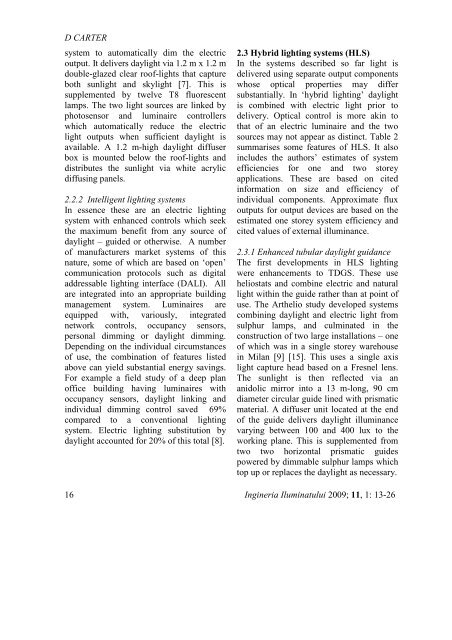ingineria iluminatului - Journal of Lighting Engineering - Prof. Florin ...
ingineria iluminatului - Journal of Lighting Engineering - Prof. Florin ...
ingineria iluminatului - Journal of Lighting Engineering - Prof. Florin ...
Create successful ePaper yourself
Turn your PDF publications into a flip-book with our unique Google optimized e-Paper software.
D CARTER<br />
system to automatically dim the electric<br />
output. It delivers daylight via 1.2 m x 1.2 m<br />
double-glazed clear ro<strong>of</strong>-lights that capture<br />
both sunlight and skylight [7]. This is<br />
supplemented by twelve T8 fluorescent<br />
lamps. The two light sources are linked by<br />
photosensor and luminaire controllers<br />
which automatically reduce the electric<br />
light outputs when sufficient daylight is<br />
available. A 1.2 m-high daylight diffuser<br />
box is mounted below the ro<strong>of</strong>-lights and<br />
distributes the sunlight via white acrylic<br />
diffusing panels.<br />
2.2.2 Intelligent lighting systems<br />
In essence these are an electric lighting<br />
system with enhanced controls which seek<br />
the maximum benefit from any source <strong>of</strong><br />
daylight – guided or otherwise. A number<br />
<strong>of</strong> manufacturers market systems <strong>of</strong> this<br />
nature, some <strong>of</strong> which are based on ‘open’<br />
communication protocols such as digital<br />
addressable lighting interface (DALI). All<br />
are integrated into an appropriate building<br />
management system. Luminaires are<br />
equipped with, variously, integrated<br />
network controls, occupancy sensors,<br />
personal dimming or daylight dimming.<br />
Depending on the individual circumstances<br />
<strong>of</strong> use, the combination <strong>of</strong> features listed<br />
above can yield substantial energy savings.<br />
For example a field study <strong>of</strong> a deep plan<br />
<strong>of</strong>fice building having luminaires with<br />
occupancy sensors, daylight linking and<br />
individual dimming control saved 69%<br />
compared to a conventional lighting<br />
system. Electric lighting substitution by<br />
daylight accounted for 20% <strong>of</strong> this total [8].<br />
2.3 Hybrid lighting systems (HLS)<br />
In the systems described so far light is<br />
delivered using separate output components<br />
whose optical properties may differ<br />
substantially. In ‘hybrid lighting’ daylight<br />
is combined with electric light prior to<br />
delivery. Optical control is more akin to<br />
that <strong>of</strong> an electric luminaire and the two<br />
sources may not appear as distinct. Table 2<br />
summarises some features <strong>of</strong> HLS. It also<br />
includes the authors’ estimates <strong>of</strong> system<br />
efficiencies for one and two storey<br />
applications. These are based on cited<br />
information on size and efficiency <strong>of</strong><br />
individual components. Approximate flux<br />
outputs for output devices are based on the<br />
estimated one storey system efficiency and<br />
cited values <strong>of</strong> external illuminance.<br />
2.3.1 Enhanced tubular daylight guidance<br />
The first developments in HLS lighting<br />
were enhancements to TDGS. These use<br />
heliostats and combine electric and natural<br />
light within the guide rather than at point <strong>of</strong><br />
use. The Arthelio study developed systems<br />
combining daylight and electric light from<br />
sulphur lamps, and culminated in the<br />
construction <strong>of</strong> two large installations – one<br />
<strong>of</strong> which was in a single storey warehouse<br />
in Milan [ 9 ]<br />
[15]. This uses a single axis<br />
light capture head based on a Fresnel lens.<br />
The sunlight is then reflected via an<br />
anidolic mirror into a 13 m-long, 90 cm<br />
diameter circular guide lined with prismatic<br />
material. A diffuser unit located at the end<br />
<strong>of</strong> the guide delivers daylight illuminance<br />
varying between 100 and 400 lux to the<br />
working plane. This is supplemented from<br />
two two horizontal prismatic guides<br />
powered by dimmable sulphur lamps which<br />
top up or replaces the daylight as necessary.<br />
16 Ingineria Iluminatului 2009; 11, 1: 13-26
















